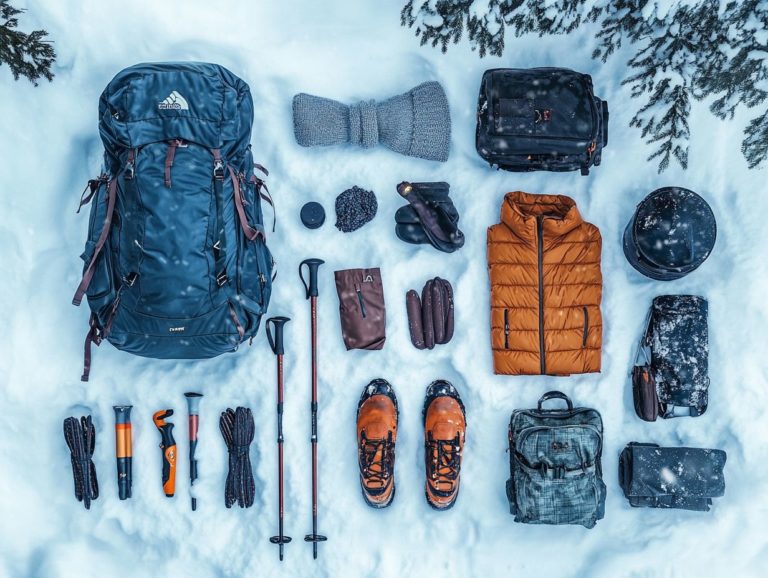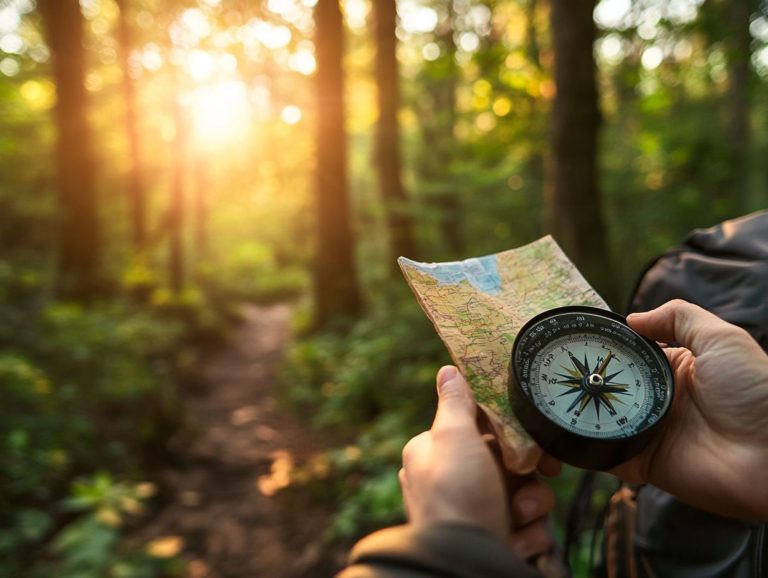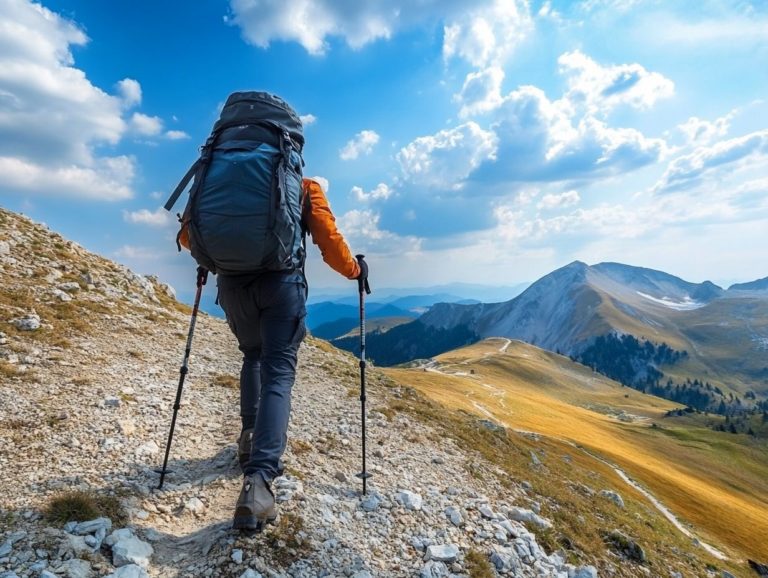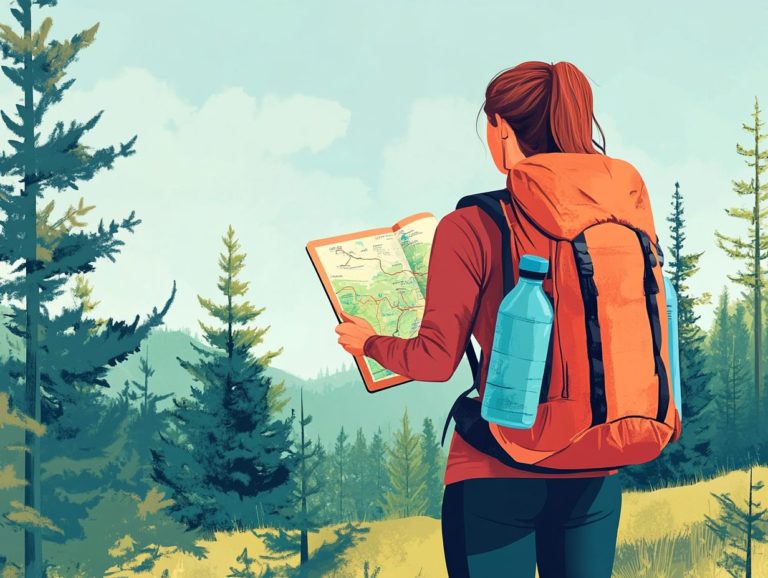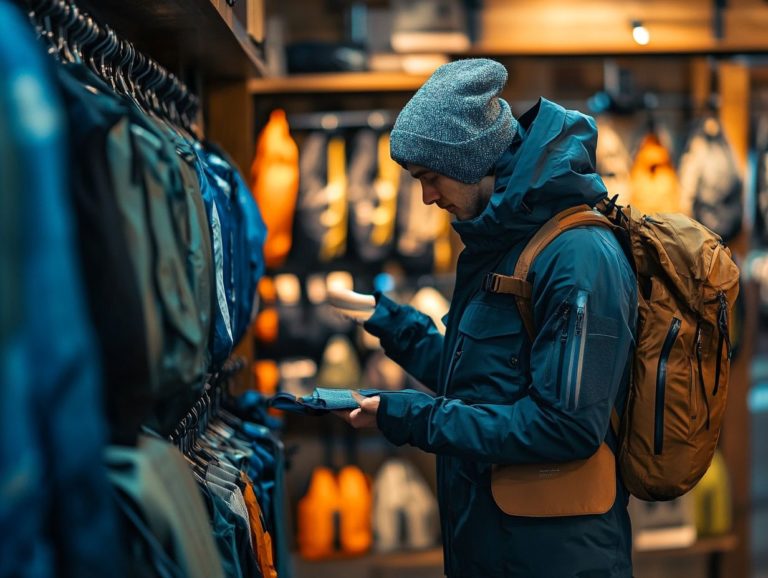Creating a Hiking Gear Checklist
Planning a hike, especially a day hike, can evoke a blend of exhilaration and apprehension, particularly when it comes to selecting the right gear.
Whether you re a seasoned adventurer or a leisurely walker, having the essentials at your disposal can significantly enhance your outdoor experience.
This guide covers all the essential gear you need for an amazing hike!
Contents
- Key Takeaways:
- 1. Essential Gear for Hiking
- 2. Clothing and Footwear
- 3. Navigation and Safety Gear
- 4. Camping Gear (If Overnight Hike)
- 5. Hydration and Nutrition Items
- 6. First Aid Kit
- 7. Personal Items and Toiletries
- 8. Optional Gear for Comfort
- 9. Choosing the Right Backpack
- 10. Tips for Packing Efficiently
- 11. What Not to Bring on a Hike
- 12. Preparing for Different Weather Conditions
- 13. Properly Maintaining and Cleaning Gear
- 14. Renting or Borrowing Gear
- 15. Creating a Customized Checklist for Your Needs
- Frequently Asked Questions
- What is a hiking gear checklist?
- Why is renting gear a good option?
- What should I include in my hiking gear checklist?
- Why is it important to create a hiking gear checklist, including hiking medications and sunscreen?
- What should be included in a hiking gear checklist?
- How can I create a hiking gear checklist?
- What are some common mistakes to avoid when creating a hiking gear checklist?
- How often should I update my hiking gear checklist?
Key Takeaways:
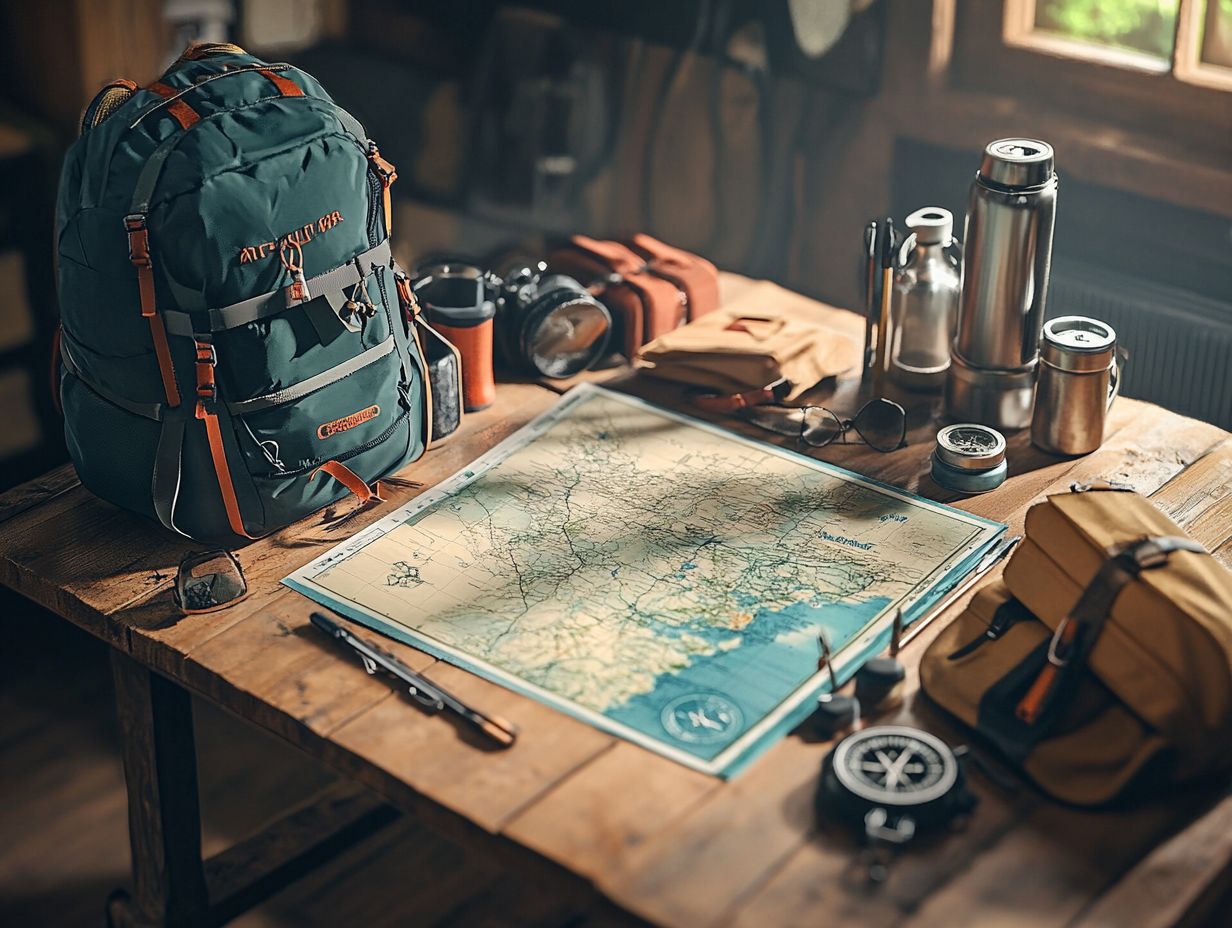
- Proper gear, clothing, and footwear are essential for a successful hike.
- Navigation, safety, and camping gear are crucial for overnight hikes.
- Be prepared for weather changes, pack efficiently, and maintain gear to ensure a safe and enjoyable hike.
1. Essential Gear for Hiking
When you set out on a day hike, having the right gear becomes essential for a successful and enjoyable outdoor adventure. Your hiking checklist is a critical component of this preparation.
This checklist helps ensure you have all necessary hiking items ready. The significance of each item cannot be overstated. They not only elevate your hiking experience but also play a vital role in your overall safety.
Trekking poles, for instance, offer extra stability on uneven terrain and alleviate strain on your knees during steep descents.
A well-stocked first aid kit includes bandages and supplies for treating minor injuries, which is critical for addressing common injuries. An emergency blanket can provide warmth during unexpected temperature drops potentially life-saving in critical moments.
If you’re venturing into wildlife-rich areas, bear spray is essential. It deters potential encounters and grants you peace of mind.
For the tech-savvy adventurer, GPS apps or devices are invaluable for navigating unfamiliar trails and preventing disorientation.
A lightweight stove can truly elevate your hiking experience, allowing you to enjoy warm meals or drinks and effectively replenish your energy levels.
When choosing high-quality gear, consider factors like material durability, weight, and functionality to ensure your equipment can withstand various trail conditions and serve you well on all your adventures.
2. Clothing and Footwear
Choosing the right outdoor clothing and footwear is essential for ensuring a comfortable and safe hiking experience. It protects you from varying weather conditions and enhances your mobility on the trail.
Selecting fabrics that keep sweat away is crucial, as they efficiently manage sweat and humidity, keeping your body dry and comfortable.
Breathable attire allows air to circulate around your skin, particularly important during strenuous hikes.
Proper footwear is key; hiking boots designed for rough terrains provide the support and grip necessary for walking on bumpy trails, while lightweight shoes might suit you better on more level trails.
Layering with cool weather gear enables you to adapt to changing temperatures with ease. Don t overlook the importance of high-quality hiking socks; they can significantly reduce the risk of blisters, ensuring your adventure is as enjoyable as possible.
Effective navigation and safety gear are paramount for ensuring you stay on course and maintain safety while hiking, especially in unfamiliar terrain or challenging weather conditions.
While modern GPS devices provide convenience and real-time information, possessing a map and compass remains a reliable backup in scenarios where technology might fail, such as in areas with poor reception or a dwindling battery.
Understanding how to use these tools boosts both your safety and enjoyment.
Equally crucial are essential hiking safety tips, such as:
- Informing someone about your planned route and expected return time,
- Packing a basic first aid kit.
Moreover, having emergency contacts readily accessible ensures that help can be summoned swiftly if unexpected situations arise, making proactive planning a critical aspect of any wilderness excursion.
4. Camping Gear (If Overnight Hike)
When you re gearing up for an overnight hike, choosing the right camping gear is vital for ensuring comfort, safety, and convenience on your outdoor adventure.
Thoughtful consideration of both weight and functionality is essential, especially when dealing with a lightweight backpack (a bag designed to carry your gear without weighing you down).
Opting for a lightweight tent can truly elevate your experience, allowing you to move swiftly without the burden of cumbersome equipment.
Likewise, a portable water filter is essential for safe hydration, guaranteeing that clean drinking water is always at your fingertips, along with collapsible water containers for easy transport, regardless of where the trail leads you.
A lightweight stove makes meal preparation a breeze, providing the energy you need to conquer your journey, especially when combined with nutritious hiking snacks.
Proper storage solutions for your hiking gear not only maximize space but also keep you organized. You’ll spend less time rummaging and more time enjoying the hike!
And don t overlook the importance of packing necessary hiking medications; they can be lifesavers when unexpected situations arise.
5. Hydration and Nutrition Items
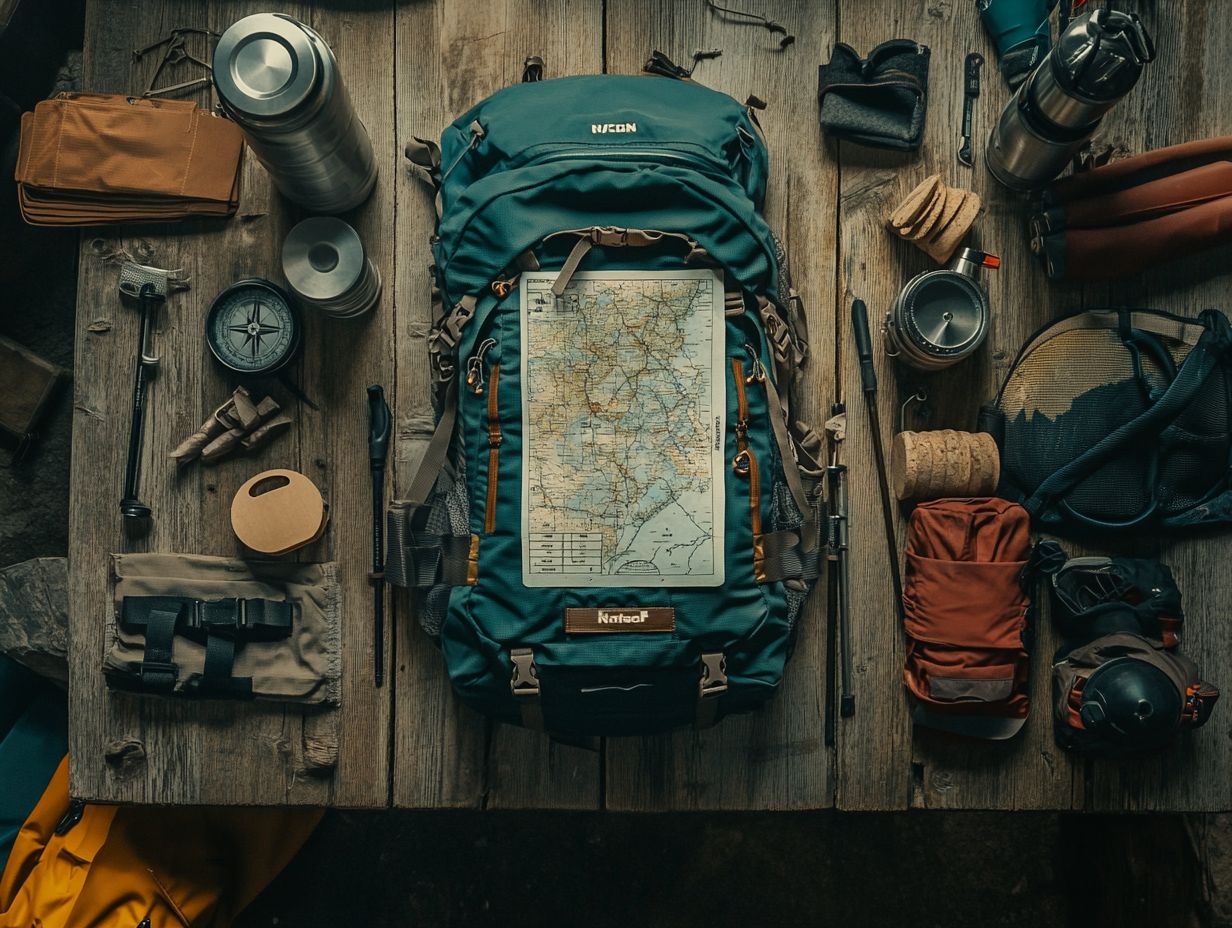
Staying hydrated and properly nourished during your hike is crucial for maintaining your energy levels and overall well-being. That makes selecting the right food and water a top priority on your hiking checklist.
As you chart your course through nature, consider the importance of adequate hydration. Choosing collapsible water containers not only minimizes bulk in your pack but also allows you to carry the essential amount of water without sacrificing space.
Fueling your body with suitable hiking snacks think nuts, energy bars, and dried fruit ensures a steady flow of energy throughout your adventure, especially when paired with plenty of food and water.
Incorporating a portable water filter changes the game, giving you easy access to safe drinking water from streams or lakes. This way, you can enhance your hiking experience and explore with confidence, free from worries about hydration.
6. First Aid Kit
A well-stocked first aid kit is an absolute must-have on your hiking gear checklist, as it equips you with the essential supplies to tackle injuries or health concerns that might pop up on the trail.
Having a variety of bandages, antiseptics, and hiking medications can truly make a difference in managing those pesky scrapes, cuts, or even allergic reactions during your outdoor escapades.
Don’t overlook the importance of packing items like an emergency blanket, which can provide crucial warmth and insulation when unexpected chills set in, and an emergency whistle to call for help if things take a turn for the worse.
These essentials work together to ensure you’re prepared for whatever surprises nature throws your way, reinforcing both your hiking safety and confidence as you explore the great outdoors.
7. Personal Items and Toiletries
When gearing up for a hike, it s crucial to think about the personal items and toiletries that will elevate your comfort and hygiene throughout the adventure.
Consider investing in a hiking phone case that offers protection from the elements, especially when engaging in outdoor adventures. This not only shields your device from potential damage but also keeps essential navigation apps and emergency contacts at your fingertips.
Don t overlook packing necessary toiletries like biodegradable wipes, hand sanitizer, and sunscreen lip balm; these items are key to maintaining cleanliness and safeguarding against the elements.
Food storage is equally important; opt for lightweight, resealable bags or airtight containers to keep your snacks fresh and easily accessible, ensuring quick energy boosts when you need them.
By addressing these details, you can immerse yourself in the beauty of nature while feeling secure and thoroughly prepared.
Prepare your gear and step into nature with confidence adventure awaits!
8. Optional Gear for Comfort
While some hiking gear is undeniably essential, don t underestimate the impact of optional gear on your comfort and enjoyment. These extras can elevate your outdoor adventure!
For instance, investing in a lightweight jacket can be a game-changer when unexpected weather rolls in, keeping you warm and dry without adding unnecessary bulk. Imagine the peace of mind that comes with being prepared for the elements.
Bringing along a hiking camera allows you to capture breathtaking moments that unfold along the trail, preserving memories you’ll cherish long after the hike is over.
And if your furry companion is tagging along, don’t overlook the importance of hiking dog gear. It ensures their safety and comfort, enhancing the overall hiking experience for both of you. After all, a happy pet makes for a happy hike.
9. Choosing the Right Backpack
Choosing the right lightweight backpack is crucial for your hike, as it directly influences your space to hold your equipment, pack weight, and overall comfort during your outdoor adventure.
As you explore your options, it s essential to consider several factors to ensure a seamless experience on the trails. The size of the backpack is crucial; it needs to accommodate your gear without becoming excessively bulky or heavy.
Comfort matters significantly too; opting for padded straps and back support can make all the difference during those long hikes. Don’t wait until the last minute choose wisely for a smoother adventure!
Functionality shouldn’t be overlooked either. Features like multiple compartments for organization can streamline your packing process, keeping everything within easy reach. Ultimately, having an effective hiking gear storage system paired with a well-organized packing list can lead to a more enjoyable and efficient expedition.
10. Tips for Packing Efficiently
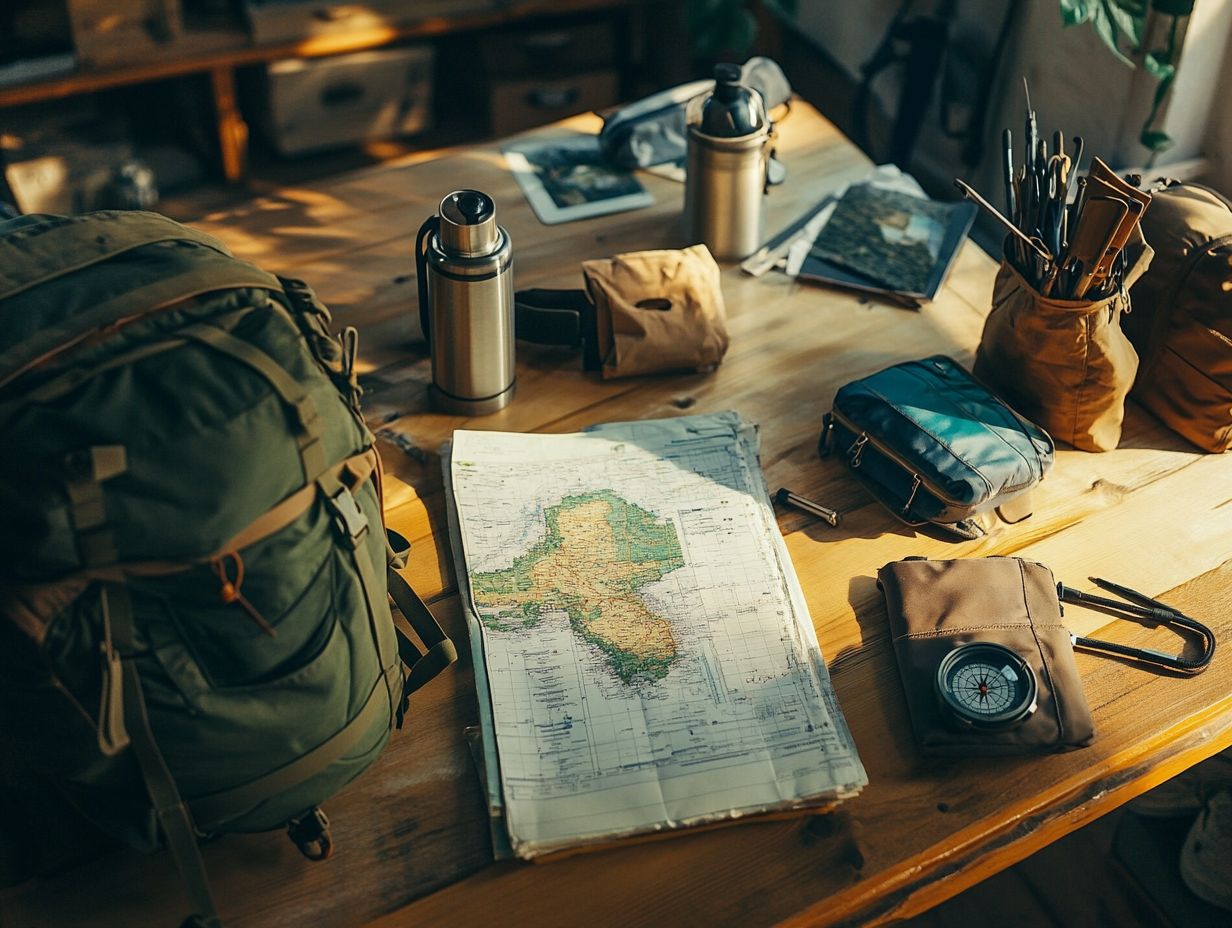
Pack smart for a successful hike. Efficient packing is crucial, enabling you to minimize pack weight while keeping all necessary items easily accessible on the trail.
To strike this balance, begin by categorizing your gear into essentials think food, water, navigation tools, and first aid supplies and comfort items, which might include a lightweight hammock or that irresistible snack you love.
It s beneficial to lay everything out before you start packing; this allows you to evaluate what truly adds value versus what might just be taking up precious space.
Using accessories like packing cubes or compression bags can streamline your organization, making it a breeze to find items quickly. Using accessories like carabiners can enhance your pack efficiency.
11. What Not to Bring on a Hike
While knowing what to pack for a hike is essential, understanding what not to bring is just as crucial for avoiding unnecessary weight and potential complications on the trail.
Many adventurers find themselves caught in the overpacking trap, tossing in items that may seem useful but ultimately weigh them down think bulky gear, excessive food supplies, or unnecessary gadgets. Not only does this sap your energy, but it can also distract you from the breathtaking scenery and the joy of connecting with nature.
To elevate your hiking experience, it’s wise to create a streamlined packing list that focuses on the essentials: water, snacks, proper clothing, and navigation tools. This approach ensures a more comfortable and enjoyable trek, allowing you to immerse yourself fully in the great outdoors. Additionally, knowing how to maintain your hiking gear will keep your equipment in top shape for every adventure.
12. Preparing for Different Weather Conditions
Preparing for various weather conditions is crucial for your hiking success. Unpredictable changes can greatly affect your comfort and safety on the trail.
To ensure an enjoyable experience, you must carefully assess the forecast before embarking on your adventure. Observe temperature ranges, wind speeds, and potential precipitation to make informed decisions about gear selection.
In cooler weather, it s essential to choose moisture-wicking base layers paired with insulating mid-layers. Finish with a waterproof outer layer to keep you dry. Don t overlook essential accessories like gloves, a hat, and sunglasses. These not only enhance your comfort but also shield you from unexpected elements like fierce winds or glaring sunlight.
Anticipating sudden climate shifts by packing an extra layer or two can truly make a difference. This preparation ensures you re ready for whatever nature throws your way.
13. Properly Maintaining and Cleaning Gear
Proper maintenance and cleaning of your hiking gear are crucial for extending its lifespan and ensuring it performs at its best during your outdoor adventures.
Regularly inspecting your equipment like tents, backpacks, and boots allows you to spot wear and tear before it escalates into a major problem. For instance, give your muddy boots a gentle scrub with a soft brush and water to prevent deterioration. Air-drying them after each trek eliminates the risk of mold.
When it comes to your tent, a gentle wash with mild soap followed by a careful rinse helps preserve the quality of the fabric. Store your gear in a cool, dry place, away from direct sunlight, to greatly reduce damage from environmental factors.
By following these straightforward practices, including checking your emergency contacts and packing an emergency blanket, you can keep your gear in top-notch condition for countless adventures to come.
14. Renting or Borrowing Gear
For those new to hiking or aiming to keep costs down, renting or borrowing gear is a great way to embrace the great outdoors without making a significant financial commitment to hiking essentials.
This approach allows access to high-quality equipment without the daunting price tag associated with purchasing new items. It also gives you the opportunity to experiment with different types of gear to discover what suits your preferences and activities best.
However, consider the pros and cons. Rentals might restrict your choices and could carry hidden fees. Borrowing from friends may not guarantee the latest or best-maintained equipment. Look for reliable rental services at local outdoor shops or through reputable online platforms, where customer reviews can steer you in the right direction. Additionally, when selecting your gear, it may be helpful to check out guidance on how to plan an outdoor gear checklist, and think about your skill level, the terrain you’ll tackle, and the length of your hike.
15. Creating a Customized Checklist for Your Needs
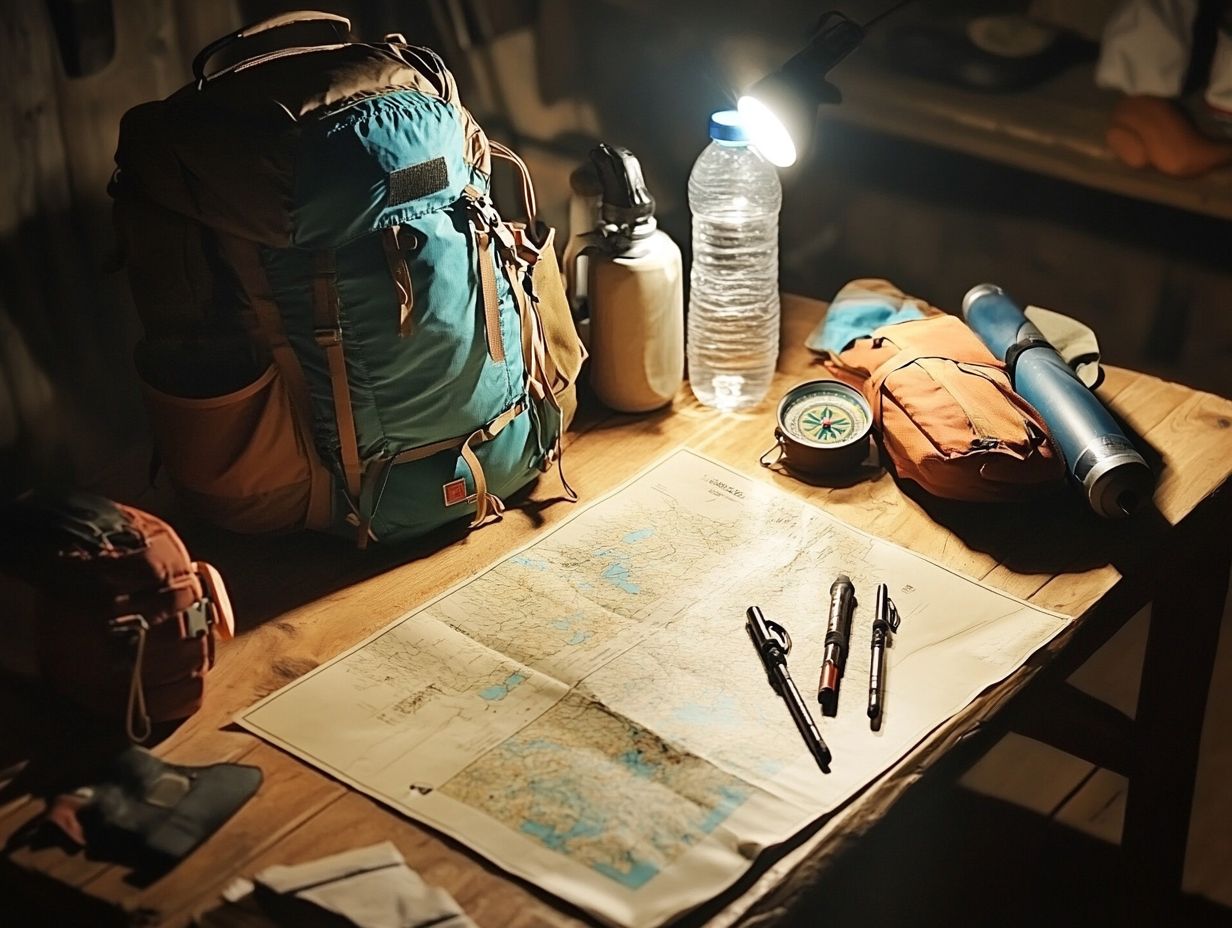
Crafting a customized hiking checklist tailored specifically to your needs is an invaluable strategy for ensuring you’re fully prepared for your outdoor escapades.
By considering various factors such as the length and difficulty of the trail, the type of terrain, and the anticipated weather conditions, you must assess your personal requirements. A short, easy stroll in pleasant weather calls for a different selection of gear than a challenging trek through rugged terrain under unpredictable skies. To help you prepare effectively, refer to the ultimate checklist for hiking gear. It’s crucial to prioritize your comfort and safety by selecting the right footwear, hydration packs, and navigation tools like maps, compasses, or GPS devices.
Adopting this thoughtful approach not only enhances your experience but also minimizes risks along the way. This allows you to fully embrace the adventure ahead.
Frequently Asked Questions
What is a hiking gear checklist?
A hiking gear checklist is a list of essential items that hikers should bring on a hike to ensure they have everything they need for a safe and enjoyable experience.
Why is renting gear a good option?
Renting gear allows you to access high-quality equipment without a big financial commitment, making it an excellent choice for beginners.
What should I include in my hiking gear checklist?
Include essentials like water, snacks, first aid kits, navigation tools, and weather-appropriate clothing.
Why is it important to create a hiking gear checklist, including hiking medications and sunscreen?
A hiking gear checklist keeps you organized. It ensures you don t forget essential items like bear spray and hiking accessories, making your hike more enjoyable.
What should be included in a hiking gear checklist?
The items in a hiking gear checklist vary based on the hike’s length and difficulty. Generally, include essentials like proper clothing, hiking pants, footwear, hydration supplies, navigation tools, and a first aid kit.
Don t forget emergency supplies, such as a portable water filter, which is a device that makes water safe to drink.
How can I create a hiking gear checklist?
Start by researching the parking area at the start of the trail, the trail itself, and the weather conditions. This will help you determine what items are necessary.
Next, list essential gear and check off each item as you pack. Ensure you have hiking tips handy. You can also customize pre-made checklists to fit your needs.
What are some common mistakes to avoid when creating a hiking gear checklist?
Common mistakes include forgetting vital items like a hiking phone case and overpacking unnecessary gear. Think carefully about each item packing wisely can make your adventure unforgettable!
Consider the weight and size of your gear to ensure you re fully prepared for any outdoor adventure.
How often should I update my hiking gear checklist?
Update your checklist before every hike, as the items you need may change with trail conditions and weather. Regularly replace old or worn-out gear to maintain its effectiveness.
Reassess your gear based on experiences from previous hikes to ensure you’re always ready for your next adventure.
Ready to hit the trails? Start your checklist today!


